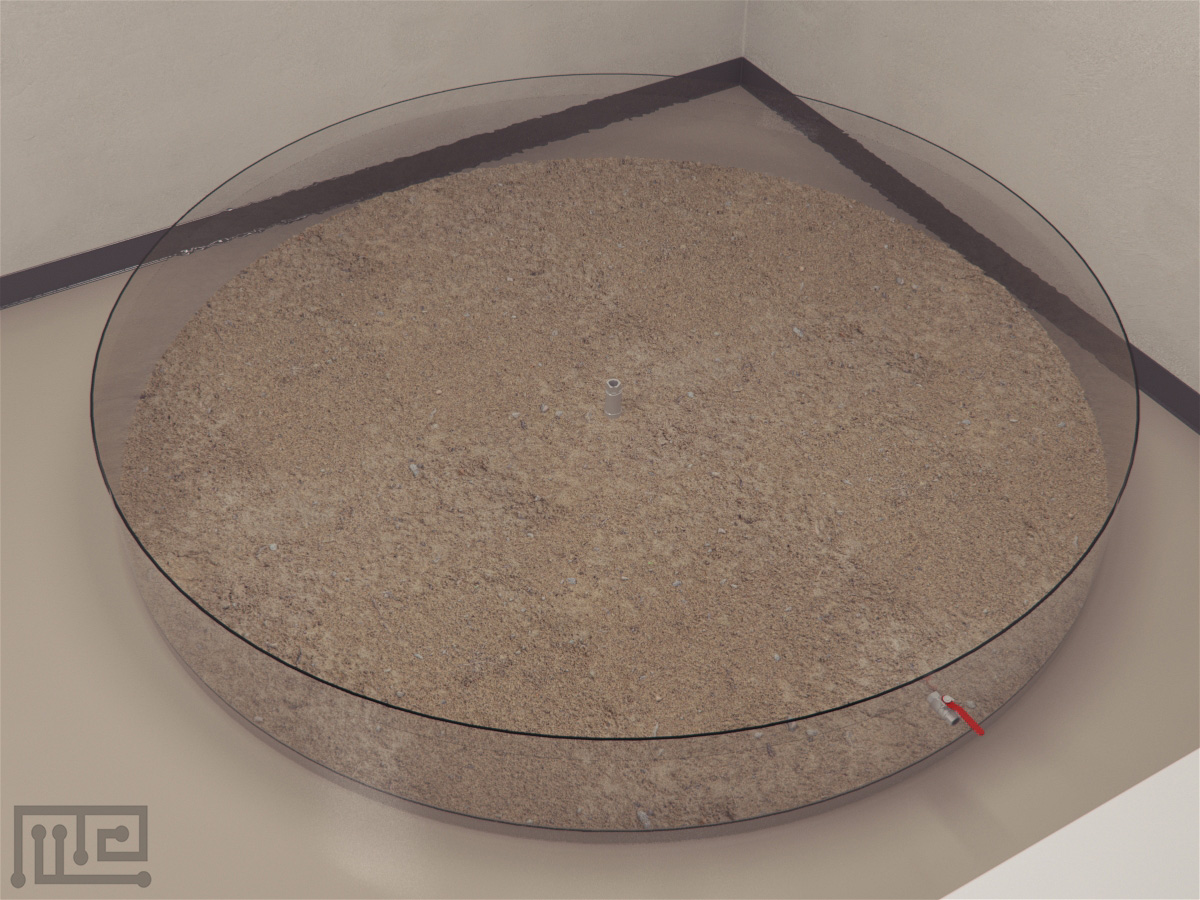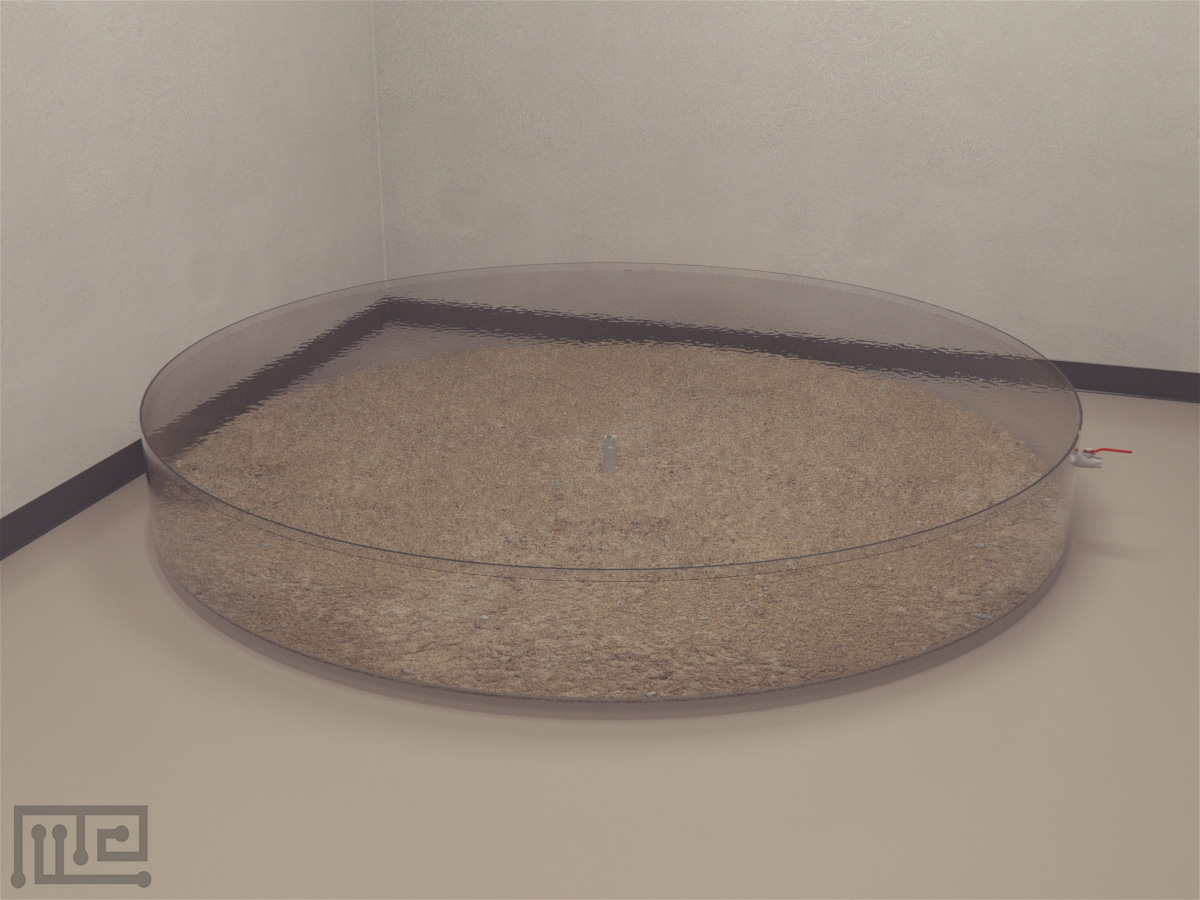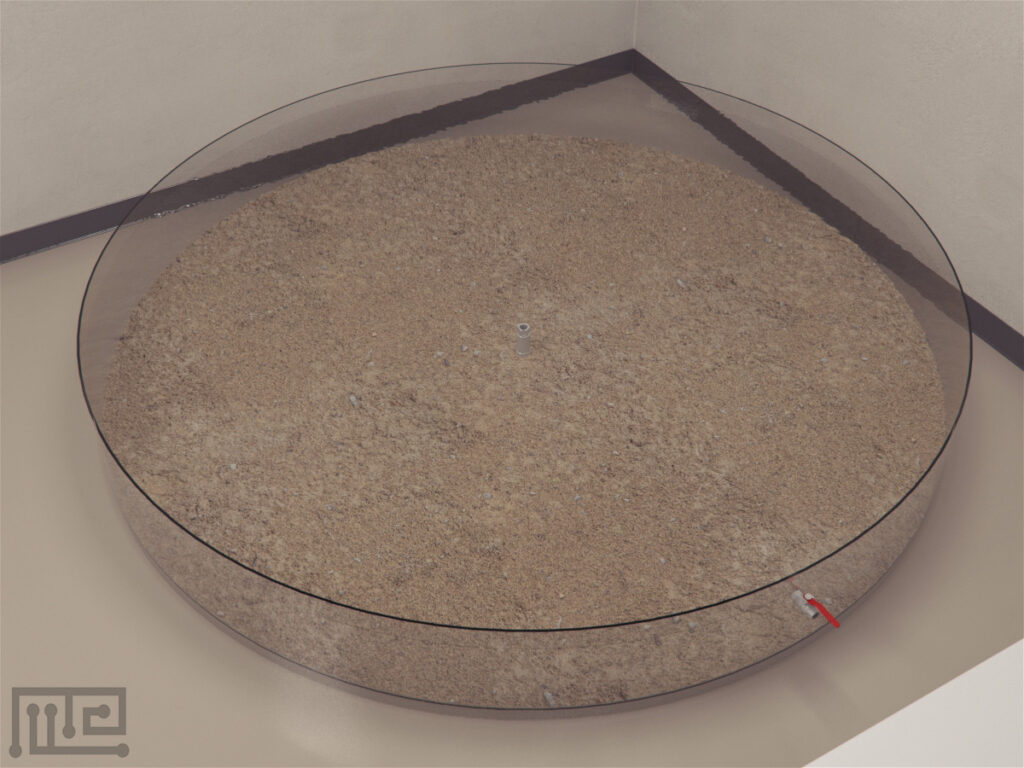The Lobster maze (postlarval conditioning with shelter) is the first of two arenas used in an experiment by Skylar R. Bayer et al. (2017), to assess the effect of postlarval conditioning with shelter in lobsters.
It is a circular open arena with continuous seawater flow, covered by a 5-cm layer of sand but containing only a single rock pile shelter. The shelter was visible from all areas of the arena except for a small region located immediately behind the central standpipe.
Mazeengineers offer the Lobster maze (postlarval conditioning with shelter).
Price & Dimensions
Lobster Maze
$ 2490
+S&H- Diameter of arena: 244cm
- Depth of arena: 60cm
- Depth of sand in arena: 5cm
- Diameter of piles of cobble: 7-15cm
- Size of cobbles: 2-5cm
Documentation
Introduction
The Lobster Maze (post-larval conditioning with shelter) is used to observe spatial learning, navigation, and shelter-seeking behaviors in lobsters. Sheltering is an important anti-predator mechanism in lobsters, especially during juvenile stages, where sheltering ensures survival. Therefore, understanding the shelter-seeking behaviors of lobsters can be beneficial for the conservation and management of their species (Agnalt, Grefsrud, Farestveit, & Jørstad, 2017).
The Lobster Maze is essentially a circular open arena covered with sand in which a shelter made of cobbles can be placed. The time the subject spends in different areas of the arena, including the shelter’s time, can be observed. Studies in lobsters have shown that environmental enrichment and social interactions improve shelter-seeking behaviors (Aspaas et al., 2016). Therefore, the Lobster Maze can effectively be used to observe shelter-seeking behaviors in response to different environmental conditions and social interactions. Since the arena is large enough to place numerous shelters, the Lobster Maze can also be used to observe the effect of post-larval conditioning with shelter on shelter-seeking behaviors. Moreover, since different lobster species prefer shelters of different shapes and sizes, the Lobster Maze can be used to observe preference behaviors towards different types of shelters.
A study on Teflubenzuron, an in-feed pharmaceutical, applied to control salmon lice outbreaks, was shown to affect learning, exploratory, and shelter-seeking behaviors in lobsters (Cresci et al., 2018). Therefore, the Lobster Maze can also be used to observe the effect of pharmacological manipulations on shelter-seeking behaviors. In addition, the effect of brain lesions, and diseases, and disorders on spatial learning, navigation, and shelter-seeking behaviors can also be studied. Another apparatus used to observe lobsters’ behaviors is the Lobster Maze (Effect Of Immediate Prior Experience).
Apparatus and Equipment
The Lobster Maze consists of a circular open arena that measures 244 cm in diameter and has continuous seawater flow. The entire floor of the arena is covered with a 5-cm layer of sand and a single rock pile shelter. At the center of the arena, a sandpipe is present. The shelter is visible from all areas of the arena except for a small region immediately behind the sandpipe. A line of pebbles that each measure < 1 cm in diameter is pressed into the sand 10 body lengths away from the shelter and forms a concentric ring around the shelter that measures 20 cm in diameter.
Training Protocol
Conduct trials during the daylight hours. Flush the maze with flow-through seawater for 5 minutes between trials. Appropriately light the apparatus. A tracking and recording system such as the Noldus Ethovision XT can be used to assist with observations.
The following is a sample protocol to measure differences in shelter-seeking behavior in naïve and conditioned first juvenile stage (stage V) lobsters.
Habituation and Pre-training
Place the “naïve” postlarvae group in the Lobster Maze that contains only a 5-cm layer of sand at the bottom. In contrast, place the “conditioned” postlarvae group in the Lobster Maze that contains a 5-cm layer of sand and 7~15 –cm diameter piles of cobbles placed around the perimeter of the arena to serve as shelters. Provide continuous inflow of seawater to the Lobster Maze. Feed all postlarvae twice a day. Remove all postlarvae from both arenas when they molt into first instar (stage V) juveniles. Place the stage V juveniles in mesh holding pens in a flow-through sea table.
Lobster Maze Task
Allow the experimenter that is blind to either treatment group (naïve or conditioned) to handle and observe the subjects. Place a single rock pile shelter in the arena. Transfer a stage V juvenile from its holding pen into a mesh acclimation pen in the arena. Allow the subject to acclimate for 2 minutes and then remove the pen. Allow the subject to explore the maze for 5 minutes. If the subject does not initiate sheltering within 5 minutes, allow it to explore the arena for an additional 15 minutes. Remove the subject from the arena and return it into its holding pen. Dismantle the shelter and reconstruct it after flushing the maze with flow-through seawater for 5 minutes. Conduct another trial on another subject.
Literature Review
Investigation of the effect of postlarval conditioning with shelter on juvenile lobsters
Bayer, Bianchi, Atema, and Jacobs (2017) investigated the effect of postlarval conditioning with shelter on juvenile shelter-seeking behaviors in lobsters using the Lobster Maze. The shelter-seeking behavior of naïve stage V juvenile lobsters was compared with conditioned stage V juvenile lobsters. The naïve group was placed in the Lobster Maze containing only sand in their postlarvae stage while the conditioned group was placed in the maze that contained sand as well as piles of cobbles that served as shelters. During testing, a single shelter was placed in the Lobster Maze, and the differences in shelter-seeking behavior between the two groups were observed by a single observer that was blind to the treatment groups. The subject’s location in the maze was observed every 5 seconds for 5 minutes. Particularly, the subject’s location within the shelter, within 10 body lengths from the shelter, and within the rest of the maze was recorded. If the subject did not initiate shelter-seeking behavior, it was allowed to explore the maze for an additional 15 minutes. The results indicated that the conditioned group took a significantly longer amount of time to initiate shelter-seeking behavior as compared to the naïve group. In addition, the conditioned group also took significantly longer to initiate sheltering after coming within 10 body lengths from the shelter. In the subjects that did not initiate sheltering within 5 minutes, no differences between the two groups were observed in time to initiate sheltering.
Data Analysis
The following parameters can be observed using the Lobster Maze:
- Time taken to initiate sheltering
- Time taken to initiate sheltering after coming within 10 body lengths of the shelter
- Time spent in the shelter
- Time spent in the rest of the maze
Strengths and Limitations
Strengths
The Lobster Maze allows observation of shelter-seeking behaviors in lobsters. It consists of an open arena covered with sand in which a single shelter or numerous shelters can be placed. Shelter-seeking behaviors towards different types of shelters that differ in size or shape can effectively be observed on the Lobster Maze. In addition, the effect of environmental enrichment, social interactions, water quality, pharmacological manipulations, and diseases and disorders on shelter-seeking behaviors can also be observed.
Limitations
Factors such as age, gender, or strain of the subjects may affect task performance. The exploratory drive of the subject is highly important in the completion of the task. Unintentional stimuli may affect task performance.
Summary
- The Lobster Maze (post-larval conditioning with shelter) is used to observe spatial learning, navigation, and shelter-seeking behaviors in lobsters.
- It consists of a circular open area covered with sand in which a shelter made of cobbles can be placed.
- The Lobster Maze can be used to observe preference behaviors towards different types of shelters.
- It can also be used to observe the effect of environmental enrichment, social interactions, and pharmacological manipulations on shelter-seeking behaviors.
References
- Agnalt, A. L., Grefsrud, E. S., Farestveit, E., & Jørstad, K. E. (2017). Training camp—A way to improve survival in European lobster juveniles?. Fisheries Research, 186, 531-537. doi:10.1016/j.fishres.2016.09.021
- Aspaas, S., Grefsrud, E. S., Fernö, A., Jensen, K. H., Trengereid, H., & Agnalt, A. L. (2016). An Enriched Environment Promotes Shelter-Seeking Behaviour and Survival of Hatchery-Produced Juvenile European Lobster (Homarus gammarus). PloS one, 11(8), e0159807. https://doi.org/10.1371/journal.pone.0159807
- Bayer, S. R., Bianchi, K. M., Atema, J., & Jacobs, M. W. (2017). Effects of Prior Experience on Shelter-Seeking Behavior of Juvenile American Lobsters. The Biological bulletin, 232(2), 101–109. https://doi.org/10.1086/692697
- Cresci, A., Samuelsen, O. B., Durif, C., Bjelland, R. M., Skiftesvik, A. B., Browman, H. I., & Agnalt, A. L. (2018). Exposure to teflubenzuron negatively impacts exploratory behavior, learning and activity of juvenile European lobster (Homarus gammarus). Ecotoxicology and environmental safety, 160, 216–221. https://doi.org/10.1016/j.ecoenv.2018.05.021
Request a quote
"*" indicates required fields



